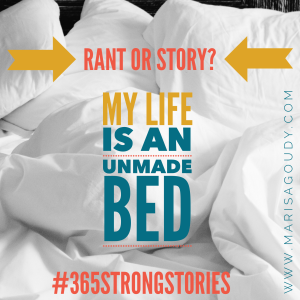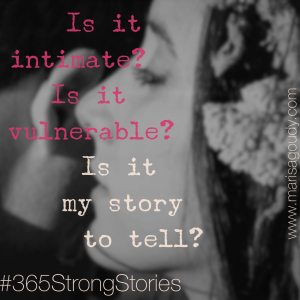
BLOG
The Art of the "Self-Focused First Draft"
Close the door. Write with no one looking over your shoulder. Don't try to figure out what other people want to hear from you; figure out what you have to say. It's the one and only thing you have to offer.”- Barbara Kingsolver
For years, I sighed with longing when I read this passage by Barbara Kingsolver. How fortunate she was to have such a healthy ego! How privileged she was to be the woman who could enter her writing room knowing that she had the power to author books that would sell. Maybe someday when I grew up I could be so free.
And so, I dedicated myself to looking over my own shoulder for a good five years. I hunched over the keyboard and scanned the web for clues about how to wear just the right chains for just long enough. Eventually, I prayed, I'd earn the right to tell the stories that mattered to me.
Because I thought it was part of paying my dues, I forced myself to choke down the “how to create viral content” KoolAid (even though I distrusted those marketing “gurus” and it killed my writer's soul).
Because I was so afraid of being revealed as a fraud, I avoided “real” writers at all cost. It seemed smarter to maintain a healthy distrust for artists and other free spirits who took Kingsolver at her word and created with wild abandon on the other side of the studio door. After all, they were the lucky ones. There was no use envying them their freedom when I still had dues to pay and chains to wear.
What changed? What made me finally realize that Kingsolver was right and that she is speaking to anyone who feels called to write at any point in the creative journey? I certainly didn’t “make it” using all those marketing formulas and trying to please the crowd. I dropped those chains because I had to.
Finally, I realized it was true: I didn’t have anything of worth to offer if I didn’t uncover the story that mattered to me. I was starving my creative passions and I wasn’t building a sustainable business. I was miserable and my writing wasn't connecting with anyone.
Permission to Write the Self-Focused First Draft
I completely believe that the stories that matter need to matter to you first.
You can’t stop there, of course - not if you want to turn those stories into online content that builds a community of people who want to invest in your vision. But before you start looking over your shoulder and before you start looking into the eyes of the people you want to serve, you must connect to your own stories.
Right now, I am developing a course called the You, Your Stories, and Your Audience. As you understand how to craft stories that matter to the people you wish to serve, you also learn the art of the Self-Focused First Draft.
Your SFFD will evolve into final draft that transforms your readers’ perspectives and compels them to take action. But before it’s asked to do anything so grand it’s rooted in exactly what you have to say. You'll learn that before you can dedicate yourself fully to anyone else, including your reader, you need to practice a healthy selfishness and tend to your own stories.
This course is for emerging thought leaders, especially therapists, healers, and coaches, who wants to build a business through blogging today and develop an online presence that will get them a book contract and big time speaking engagements in the future.
Get all the course details and save your seat for the May 2 launch!
Crafting Vision Into Story
“I don't want to eke out my life like a resource in short supply. The only selfish life is a timid one. To hold back, to withdraw, to keep the best in reserve, both overvalues the self, and undervalues what the self is.” ― Jeanette Winterson, The Powerbook
A fresh green force thrums within me. It’s at once the rush of the ocean between two rocks and the ecstasy of spring in the narrow passage of a daffodil stem.
It is life. It is creation. It is the riotous movement of energy in a conscious, interconnected world. It is peace and wildness, a great force and wisest surrender.
There’s a hint of death and the inevitable cycle renewal in this celebration of aliveness too, but I’m not lingering on that right now.
This great movement and power, it terrifies me as much as it excites me. Despite my dreams and my ambitions and my yearning to leave a creative, benevolent mark on this world, I fear this great force. To give this much, to be capable of so much would disrupt the relatively quiet, predictable existence I have become so used to.
This vision of an internal sea and rising spring is just that: a visualization thrown against the screen of my mind. And yet, it’s also very real. Or, at least it can lead to very real things.
When I agree to allow that green swell of energy to be real enough to move me, life will expand and grow and change. It would be inconceivable that I could continue to eke out my life like a resource in short supply.
What a lovely picture. Now where’s the reader’s story in all that?
Alone, these musings paired with a Jeanette Winterson passage don’t have the force of story. If I’m lucky, I may offer up just enough poetry and inspiration to keep you interested, dear reader. In this noisy world of clickbait, the emphasis on “news you can use,” and ad copy structured to appeal to the bits of the brain that can be manipulated into action, I’m not counting on it. Especially because you come to me for stories of entrepreneurship and motherhood and writing advice, not abstract snapshots from my meditation cushion.
To really make you care, to make this into a story you can see and feel and find yourself inside, I would need to anchor you in something other than the rushing river of universal life force energy. You need to follow my journey, but how?
Slip that vision into a real life context
To feel like my story matters to you, perhaps you need to watch this vision interrupt my daily life. You need to see this experience loom larger than all my excuses about sleep deprivation and the incessant interruptions of children and the madness of trying to run a family and a business and a creative existence.
The story’s conflict might come when I realize I can no longer collapse into my limitations - not if I want to honor this magical energy and live abundantly. You could accompany me as I fight against my old ways of numbing myself - red wine, chocolate, and a good Netflix binge. The big climax may be an argument with my husband since we tend to escape to the couch together and it’s always hard on a marriage when one partner commits to transformation.
And the resolution of my story (hopefully!) comes in the form of a creative triumph and a deeper dedication to this brilliant life force.
As always, ask yourself if this story is even worth telling (on your blog, in this moment)
That sort of story I outline above is more complicated to tell - at least if you want to make it a worthwhile read! And anyway, in my case, it would be fiction rather than memoir because I haven’t lived the story and earned the right to tell it all.
Then again, there’s a risk in waiting til there’s a beginning, middle, and end. The transcendent moment that started it all may start to fade. When I juxtapose the mundane details and the marital discord and the spiritual download, the whole thing may seem artificial and forced and even irrelevant.
Today, I’m describing this flash of insight because putting it on the page makes it real for me. I am publishing it because this #365StrongStories project gives me a platform to share something that’s personal and a little bit outside the lines of what I am “supposed” to write about as a writing coach.
Depending on the nature of your work and the goal of your own blog, however, your own a storyless story might find a better home in a Facebook post or in an email to a friend.
But please, don't hold the best of yourself in reserve
That said, if you’ve got something tremendous bubbling up inside, don’t hoard it and save it until all the magic leeches out of it. Even if it feels merely curious, give it a chance to become something that matters.
Dare to birth your big, brave, “this one burns the old script” ideas. Otherwise, we're left to wander mostly comatose in the world of dull, safe, useful blog posts. The forces that keep us small and miserly will win.
Do remember: “The only selfish life is a timid one.”
Is That a Rant or a Story?
 This morning as I rushed from room to room gathering necessary clothes and snacks and computer accessories and toys, it occurred to me:
My house is like an unmade bed.
This morning as I rushed from room to room gathering necessary clothes and snacks and computer accessories and toys, it occurred to me:
My house is like an unmade bed.
I was tangled in the twisted bed clothes of an entire household of stuff. Everything I needed was lost in this riot of a rumpled nest and it felt nearly impossible to meet the day.
This blistering tirade fueled my mad dash (because, of course, one girl had to make the bus and another had to be dropped at playgroup exactly on time so that mama could make her daylong VIP session with a client).
Once I was safely belted into a quiet car with my coffee, I began composing the day’s story in my head, so pleased that I had such a powerful image and title. But then I paused.
Was I a storyteller or a cranky woman who just wanted to score some sympathy points for performing the impossible? (At this point, I realized that I wasn’t a righteous super hero. I would probably just sound like a disorganized creature who, though hilariously human, was also a trifle whiny.)
Do you want to entrance them with story or blind them with shared rage?
A strong story is compelling. It moves the reader to say “me too!” and click share. Of course, the same can be true in the case of a red hot rant that pushes your audience’s buttons.
But one of these is likely to be full of gory details that you don’t want to revisit or defend in conversation. It’s about a topic that’s too intimate, too raw, too prone to morning after regret.
When you think about it that way, if you’re writing to build your business and establish your professional reputation, you want to avoid that kind of TMI like the plague.
An authentic blog post is intended to give people a window into your world, but the goal is to hold onto a few shreds of dignity and authority so that readers will say “I want to work with that human.”
A story is a well processed piece of prose that features a beginning, a middle, and an end. It has a conflict and a resolution and a protagonist you can root for.
When you write a story, you want to be vulnerable, but you’re not yowling about an open wound like you might in a full blooded rant. Instead, you’re showing off your healed scars with a smile.
How do you know when your post is more diatribe than engaging story?
A rant doesn’t have a strong ending. It may not even have a clear beginning. It’s all messy middle as far as your harangue colored glasses can see.
There’s plenty of conflict, but resolution hides below the horizon of a limitless sea of indignation.
Now, your rant may have characters - generally the wounded party (who may or may not be you, the writer) and the evil perpetrator (an actual villain or just the beasts of excess and chaos). In your unfiltered narrative, you might not be able to make your hero likeable enough to root for. An angry victim will boil alone in her vitriol if she doesn’t have a plot to hold her and prove her case.
Ask yourself: how do I want to connect?
We live in the age of storytelling, not in the age of tirades.
Ok, so that is a total lie seeing as we are living through an American presidential campaign, but we really are in a golden age of storytelling when we get to market our businesses not through newspaper ads but through content that connects.
An emotional explosion might bring the right people through your door. But, most often, those rants will fall flat and keep keep your ideal clients at arm’s length. How can they see the solutions you offer through the drama you describe?
Write stories, not rants. Your readers and your business will thank you for it.
Need some help telling a story that connects? Download your free strong storytelling guide now.
Is it intimate? Is it vulnerable? Is it my story to tell?
 Writing a story a day is a mad, marvelous mission. Time constraints and the very real limitations on creative energies are valid concerns that might make you quit before you begin.
Another reason to think twice about asking your creative impulses to take the shape of something that can be fully expressed within a twenty-four hour period: the strong stories often want to take a lot longer to be conceived, born, and debuted in this strange, complex world.
Writing a story a day is a mad, marvelous mission. Time constraints and the very real limitations on creative energies are valid concerns that might make you quit before you begin.
Another reason to think twice about asking your creative impulses to take the shape of something that can be fully expressed within a twenty-four hour period: the strong stories often want to take a lot longer to be conceived, born, and debuted in this strange, complex world.
After two months of shaping and sharing these stories, I have finally started to recognize a story that needs to germinate. It would be a disservice to the narrative, the reader, and to me as a writer to force a certain kind of story to sing and perform before it can even cry out its own name.
When you force yourself to work on a deadline, however, it’s nearly impossible to abandon a story that’s three quarters written - especially if it took more than the hour you told it that it deserved.
Today, I wrestled with a story for a couple of hours only recognized that we both needed a rest when it bloomed past the 800 word mark. In a few days, I might be able to tell you if it was a lost cause journal entry with delusions of grandeur or if it’s something real and important that wants to reach beyond the scope of #365StrongStories.
How can you tell if your story needs to be nurtured in secret or if needs to be shoved (lovingly) into the light?
First, follow Brene Brown’s wisdom: is the story intimate or is it vulnerable?
Is the story full of gory details that you don’t want to describe or defend in conversation? That’s too intimate to share.
Or do you feel brave and proud and just the right amount of scared? That’s vulnerability and that’s at the core of every strong story.
And second, ask yourself whether it is your story to tell. If neither intimacy or vulnerability seem relevant to the equation, your story might be asking you to dive deeper or revisit it when you’ve really got something to say.
Sticky subjects that might stink of shame
The story I’m not ready to tell is about parent shaming. I’m very much inspired by Mercedes Samudio’s #EndParentShame work and I was triggered by an exchange I saw in a Facebook group today. It’s such an important topic that we need to start talking about across our communities.
Thing is, I felt nauseated rather than exhilarated as my fingers flew across the keyboard. I think I was more of a voyeur than an ethical memoirist describing her experiences.
All of those are signs that I’m sharing the wrong details about the wrong aspect of a greater truth. You, my story, and my integrity as a storyteller deserve more.
If it’s a strong story, it will wait.
It's my mission to help you discover and tell the strong stories that matter to you, your audience, and your business. Learn more about the You, Your Stories, and Your Audience eCourse.

Corporate Lawyers Who Do Our Emotional Heavy Lifting, #365StrongStories 48
 Will they ever find out that Mike is a fraud?
No, not Mike my husband. I’m talking about Mike Ross, attorney at Pearson, etc.
Will they ever find out that Mike is a fraud?
No, not Mike my husband. I’m talking about Mike Ross, attorney at Pearson, etc.
I really worry about Mike, even though he’s not real. Actually, I worry about him because he’s not real. There’s almost no plausible scenario that would put us in the same circles. No, I only care about him because some screenwriter got the formula just right.
My husband and I owe a great Mike and his colleagues on Suits. Over the last few months, their high stakes corporate takeovers, epic spats, and captivating wardrobe choices have been like a trip to the spa (even better than “mudding”). Because absolutely no one on the show has children, it packs an even more satisfying escapist punch than Game of Thrones.
But then, there was the episode we watched last night - dead parents, infidelity, professional betrayal, fear of being alone, Catholic guilt, and being found out as a fraud. Messy, human stuff that you couldn’t tune out after a five-season investment. So much for escape!
This is what stories are supposed to do, you see. They’re supposed to be addictive excursions that open us to experience terrible, wonderful, tantalizing things. When the fear and pleasure centers are triggered, the brain honestly doesn’t know the difference between fiction and reality. That's why stories make us care and cry and even change the way we think.
And the ending of this particular episode was devastating. Usually, of course, autoplay would do its magic and we’d only teeter on the cliffhanger edge for a few moments. But it was a Tuesday night, and husband was feeling strong and virtuous, so he clicked the TV off.
Here's the thing about story addiction: when you don’t get your next hit, you just might have to feel something for a while.
Both of us sat there staring at the blank screen willing the clock backward so we could dive deep into this pinstripe sea and put off real life for another 44 minutes. In this silence, I felt the swell of unbidden emotions. My husband sensed the rush within me - it’s quite easy to hear your partner’s ragged breath when it’s not competing with “Previously, on Suits…”
All those lawyer problems had triggered my own doubts and fears, and though the details are as different as a Hyundai and a Bentley, the pain was universal enough.
In this binge watching culture, we’ve denied ourselves access to the real power of all these stories. We revel of the abundance of “more good TV than one could watch and still have a job!” and deny ourselves the divinely unsatiated state when we see just enough to feel something real.
